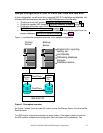
Overview of FlashCopy
5
Overview of Copy Services
Copy Services is a separately priced feature of the ESS, which provides powerful
functions for replication of mission-critical data. For the Open Systems environment
Copy Services offer point-in-time replication with FlashCopy and dynamic synchronous
mirroring to a remote ESS with Peer-to-Peer Remote Copy (PPRC). The examples
described in this paper use FlashCopy.
FlashCopy creates instant point-in-time copies of logical volumes (LVs) for purposes
such as data backup or data duplication. The copy is called time-zero (T0) copy. It is a
binary copy that looks exactly the same as the source volume at the time the copy was
made.
When executing FlashCopy the ESS establishes the FlashCopy pairs and creates
control bitmaps. This only takes a few seconds. Both source and target volumes can be
accessed immediately after the FlashCopy pairs have been established, and the bitmaps
created. Background tasks continue copying the data from the source to the target
volumes. The FlashCopy relationship between source and target volume ends when the
physical background copy tasks completed. Source and target volume can be accessed
and modified independently.
FlashCopy can also be used with the ‘no copy’ option. This suppresses copying of the
complete source volume. Only the data that changes on the source volume is copied to
the target volume before the changes are made on the source volume. The FlashCopy
relationship between source and target volume exists until it is withdrawn manually.
When the FlashCopy relationship ends, the copy is no longer available for use.
Here are the restrictions for FlashCopy:
• A FlashCopy relationship can only be established between disk volumes. Source
and target volumes have to reside within the same Open System’s Logical
Subsystem (LSS).
• The target disk must have the same size as the source volume or must be
bigger.
• Both source and target volumes can only be involved in one FlashCopy
relationship at a time
• The target can only be used on the same operating system.
Copy Services run inside the ESS. FlashCopy can be used to quickly create copies of
production data for the purpose of taking backups, creating test systems, or creating
database copies for data mining purposes or data warehouses. FlashCopy has no
significant impact on the performance nor does it require downtime of the production
system.
Using PPRC, one ESS has to be defined as the Primary Copy Services Server. This
ESS holds all Copy Services related information (i.e. the volumes and their current
state). Optionally a second ESS could be defined to be the Backup Copy Services
Server. On each ESS that is intended to use Copy Services there is a Copy Services
client running which communicates with the server. Access to Copy Services is provided
through an Internet browser. This allows for controlling the ESS copy functionality over
the network from any platform for which the browser is supported.


















